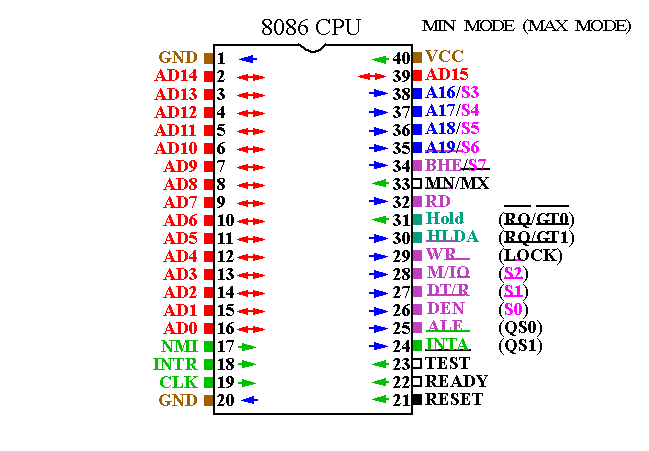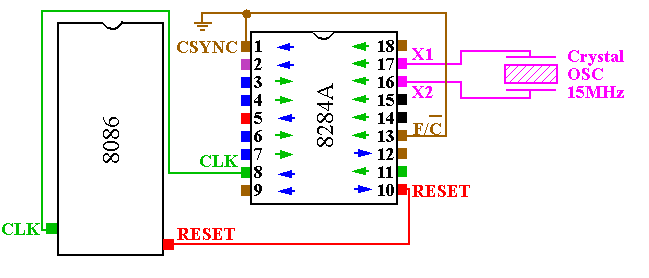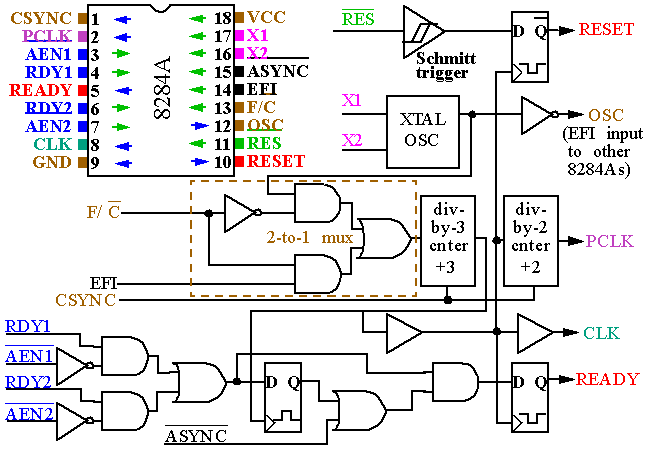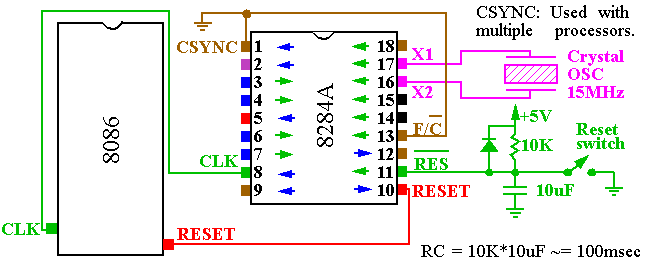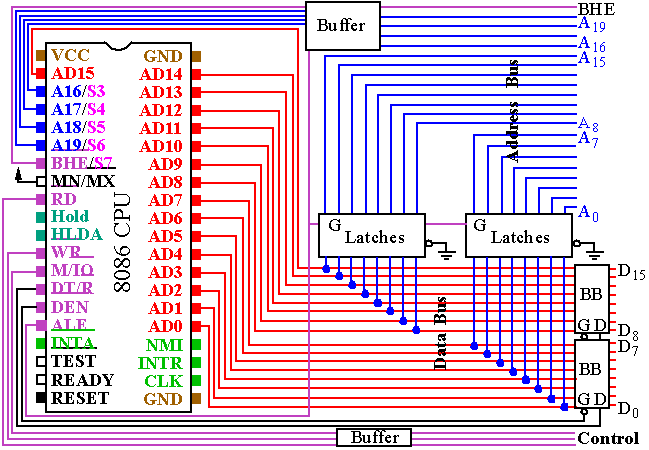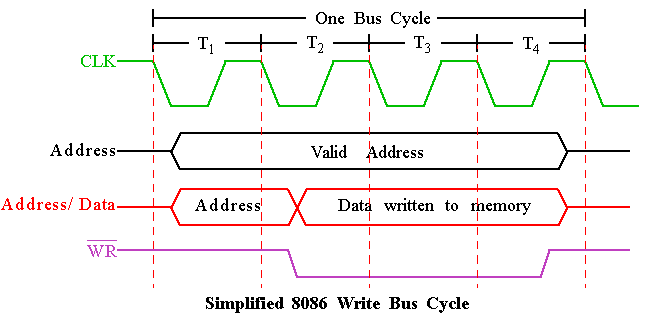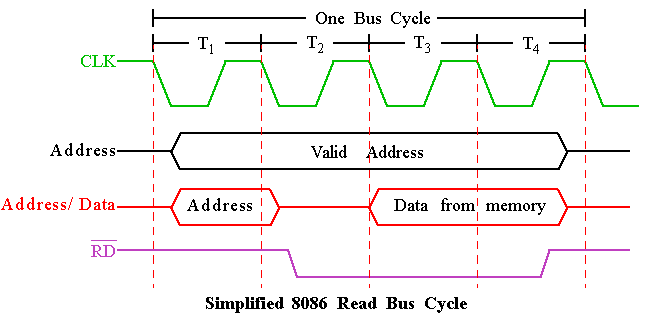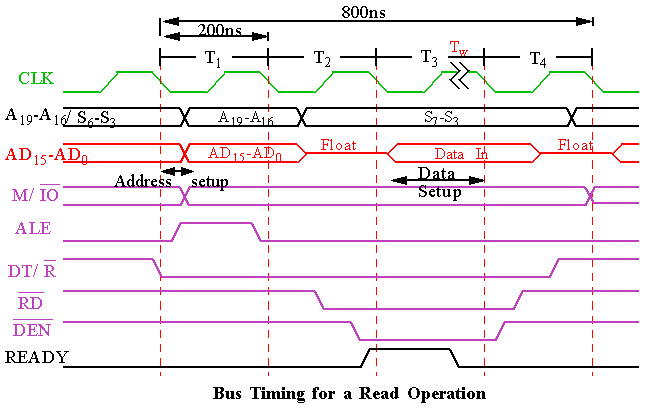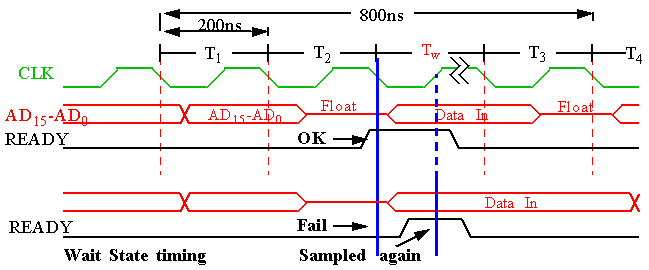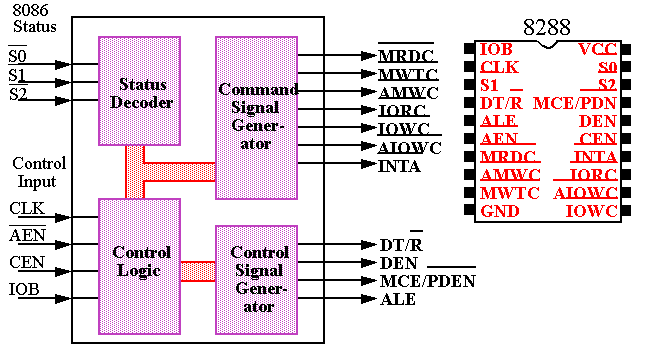-
Both are packaged in DIP (Dual In-Line Packages).
-
8086: 16-bit microprocessor with a
16-bit
data bus
-
8088: 16-bit microprocessor with an
8-bit
data bus.
-
Both are 5V parts:
-
8086: Draws a maximum supply current of 360mA.
-
8086: Draws a maximum supply current of 340mA.
-
80C86/80C88: CMOS version draws 10mA with temp spec -40 to 225degF.
-
Input/Output current levels:
-
Yields a 350mV noise immunity for logic 0 (Output max can be as high as 450mV while input max can be no higher than 800mV).
-
This limits the loading on the outputs.
-
Pin functions:
-
AD15-AD0
-
Multiplexed address(ALE=1)/data bus(ALE=0).
-
A19/S6-A16/S3 (multiplexed)
-
High order 4 bits of the 20-bit address OR status bits S6-S3.
-
M/IO
-
Indicates if address is a Memory or IO address.
-
RD
-
When 0, data bus is driven by memory or an I/O device.
-
WR
-
Microprocessor is driving data bus to memory or an I/O device. When 0, data bus contains valid data.
-
ALE (Address latch enable)
-
When 1, address data bus contains a memory or I/O address.
-
DT/R (Data Transmit/Receive)
-
Data bus is transmitting/receiving data.
-
DEN (Data bus Enable)
-
Activates external data bus buffers.
-
Pin functions:
-
S7, S6, S5, S4, S3,
S2, S1, S0
-
S7: Logic 1, S6: Logic 0.
-
S5: Indicates condition of IF flag bits.
-
S4-S3: Indicate which segment is accessed during current bus cycle:
-
S2, S1, S0
: Indicate function of current bus cycle (decoded by 8288).
-
Pin functions:
-
INTR
-
When 1 and IF=1, microprocessor prepares to service interrupt.
INTA
becomes active after current instruction completes.
-
INTA
-
Interrupt Acknowledge
generated by the microprocessor in response to INTR. Causes the interrupt vector to be put onto the data bus.
-
NMI
-
Non-maskable interrupt. Similar to INTR except IF flag bit is not consulted and interrupt is vector 2.
-
CLK
-
Clock input must have a duty cycle of 33% (high for 1/3 and low for 2/3s)
-
VCC/GND
-
Power supply (5V) and GND (0V).
-
Pin functions:
-
MN/
MX
-
Select minimum (5V) or maximum mode (0V) of operation.
-
BHE
-
Bus High Enable. Enables the most significant data bus bits (D
15
-D
8
) during a read or write operation.
-
READY
-
Used to insert wait states (controlled by memory and IO for reads/writes) into the microprocessor.
-
RESET
-
Microprocessor resets if this pin is held high for 4 clock periods.
-
Instruction execution begins at FFFF0H and IF flag is cleared.
-
TEST
-
An input that is tested by the WAIT instruction.
-
Commonly connected to the 8087 coprocessor.
-
Pin functions:
-
HOLD
-
Requests a direct memory access (DMA). When 1, microprocessor stops and places address, data and control bus in high-impedance state.
-
HLDA (Hold Acknowledge)
-
Indicates that the microprocessor has entered the hold state.
-
RO/GT1
and
RO/GT0
-
Request/grant pins request/grant direct memory accesses (DMA) during maximum mode operation.
-
LOCK
-
Lock output is used to lock peripherals off the system. Activated by using the LOCK: prefix on any instruction.
-
QS1 and QS0
-
The queue status bits show status of internal instruction queue. Provided for access by the numeric coprocessor (8087).
-
Basic functions:
-
Clock generation.
-
RESET synchronization.
-
READY synchronization.
-
Peripheral clock signal.
-
Connection of the 8284 and the 8086.
-
Clock generation:
-
Crystal is connected to X1 and X2.
-
XTAL OSC generates square wave signal at crystal's frequency which feeds:
-
An inverting buffer (output OSC) which is used to drive the EFI input of other 8284As.
-
2-to-1 MUX
-
F/
C
selects XTAL or EFI external input.
-
The MUX drives a divide-by-3 counter (15MHz to 5MHz).
-
This drives:
-
The
READY
flipflop (READY synchronization).
-
A second
divide-by-2 counter
(2.5MHz clk for peripheral components).
-
The
RESET
flipflop.
-
CLK
which drives the 8086 CLK input.
-
RESET:
-
Negative edge-triggered flipflop applies the RESET signal to the 8086 on the falling edge.
-
The 8086 samples the RESET pin on the rising edge.
-
Correct reset timing requires that the RESET input to the microprocessor becomes a logic 1 NO LATER than 4 clocks after power up and stay high for at least 50us.
-
Demultiplexing the Buses:
-
Computer systems have three buses:
-
Address
-
Data
-
Control
-
The Address and Data bus are multiplexed (shared) due to pin limitations on the 8086.
-
The ALE pin controls a set of latches.
-
All signals MUST be buffered.
-
Latches buffer for A
0
-A
15
.
-
Control and A
16
-A
19
+
BHE
are buffered separately.
-
Data bus buffers must be bi-directional buffers (BB).
-
BHE
: Selects the high-order memory bank.
-
Writing:
-
Dump address on address bus.
-
Dump data on data bus.
-
Issue a write (
WR
) and set M/
IO
to 1.
-
Reading:
-
Dump address on address bus.
-
Issue a read (
RD
) and set M/
IO
to 1.
-
Wait for memory access cycle.
-
During T
1
:
-
The address is placed on the Address/Data bus.
-
Control signals M/
IO
, ALE and DT/
R
specify memory or I/O, latch the address onto the address bus and set the direction of data transfer on data bus.
-
During T
2
:
-
8086 issues the
RD
or
WR
signal,
DEN
, and, for a write, the data.
-
DEN
enables the memory or I/O device to receive the data for writes and the 8086 to receive the data for reads.
-
During T
3
:
-
This cycle is provided to allow memory to access data.
-
READY is sampled at the end of T
2
.
-
If low, T
3
becomes a wait state.
-
Otherwise, the data bus is sampled at the end of T
3
.
-
During T
4
:
-
All bus signals are deactivated, in preparation for next bus cycle.
-
Data is sampled for reads, writes occur for writes.
-
Timing:
-
Each BUS CYCLE on the 8086 equals
four
system clocking periods (T states).
-
The clock rate is
5MHz
,
therefore one Bus Cycle is
800ns
.
-
The transfer rate is
1.25MHz
.
-
Memory specs (memory access time) must match constraints of system timing.
-
For example, bus timing for a read operation shows almost
600ns
are needed to read data.
-
However, memory must access faster due to setup times, e.g. Address setup and data setup.
-
This subtracts off about
150ns
.
-
Therefore, memory must access in at least
450ns
minus another
30-40ns
guard band for buffers and decoders.
-
420ns
DRAM required for the 8086.
-
READY:
-
An input to the 8086 that causes wait states for slower memory and I/O components.
-
A wait state (T
W
) is an extra clock period inserted between T
2
and T
3
to lengthen the bus cycle.
-
For example, this extends a
460ns
bus cycle (at 5MHz clock) to
660ns
.
-
Text discusses role of 8284A and timing requirements for the 8086.
-
Controlled through the MN/
MX
pin.
-
Minimum mode
is cheaper since all control signals for memory and I/O are generated by the microprocessor.
-
Maximum mode
is designed to be used when a coprocessor (8087) exists in the system.
-
Some of the control signals must be generated externally, due to redefinition of certain control pins on the 8086.
-
The following pins are lost when the 8086 operates in
Maximum mode
.
-
ALE
-
WR
-
IO/
M
-
DT/
R
-
DEN
-
INTA
-
This requires an external bus controller: The
8288 Bus Controller
.
-
Separate signals are used for I/O (
IORC
and
IOWC
) and memory (
MRDC
and
MWTC
).
-
Also provided are advanced memory (
AIOWC
) and I/O (
AIOWC
) write strobes plus
INTA
.

